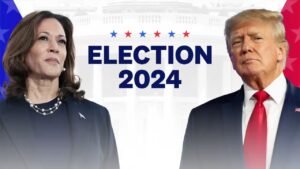Understanding the U.S. Presidential Election: A Guide to Democracy in Action
The U.S. presidential election is a cornerstone of democracy, shaping the country’s future and impacting the global stage. Every four years, millions of Americans come together to cast their votes and decide who will lead the nation as President of the United States. But what makes this process so significant? How does it work, and why does it matter so much? This article dives deep into the heart of the U.S. presidential election, explaining its history, process, and importance in simple yet insightful terms.
What Is the U.S. Presidential Election
The U.S. presidential election is the process by which citizens of the United States elect their head of state and government. The President has one of the most influential roles in the world, making decisions that affect not just Americans but also global politics, economies, and security.
Unlike many other countries, the United States uses an Electoral College system rather than a direct popular vote to determine that its presidential system has been part of the election process since its founding.
In short, the U.S. presidential election is not just about choosing a leader; it’s about upholding the principles of democracy and ensuring the people’s voices are heard.
A Brief History of the U.S. Presidential Election
The U.S. presidential election system has evolved significantly since its inception in 1788. Here’s a quick look at some key moments:
- 1789: George Washington became the United States’ first President, running unopposed.
- 1824: For the first time, the candidate who won the popular vote (Andrew Jackson) did not win the presidency due to the Electoral College.
- 1870: The 15th Amendment granted African American men the right to vote.
- 1920: The 19th Amendment gave women the right to vote, marking a massive milestone in voting rights.
- 1965: The Voting Rights Act eliminated racial discrimination in voting, further strengthening democracy.
These moments highlight how the U.S. presidential election has changed over time to ensure more inclusivity and fairness.
How Does the U.S. Presidential Election Work?
The U.S. presidential election process can seem a bit complicated at first glance, but breaking it down step by step makes it easier to understand:
1. Primary Elections and Caucuses
Before the general election, political parties hold primary elections and caucuses in each state. These events help narrow down the field of candidates to one nominee per party.
- Primaries: Citizens vote privately to choose their preferred candidate.
- Caucuses are more like town hall meetings, where voters discuss and debate before deciding on a candidate.
2. National Conventions
OEach party holds a Each party has a national convention ational onvntiononceoncethe primaries and caucuses are over, Here, the chosen nominee formally accepts their candidacy and announces their running mate for Vice President.
3. The General Election
This is the main event! On Election Day, voters across the country cast their ballots for their preferred candidate.
4. The Electoral College
Here’s where it gets interesting. Instead of a simple majority vote deciding the winner, the U.S. presidential election relies on the Electoral College. Each state is assigned several electors based on its population, and these electors ultimately decide the election.
- A total of 538 electors make up the Electoral College.
- A candidate needs at least 270 electoral votes to win.
5. Inauguration Day
Once the votes are counted and the winner is certified, the new President is sworn in on January 20th.
Why Does the Electoral College Matter?
The Electoral College is one of the most debated aspects of the U.S. presidential election. While it ensures that smaller states have a voice, it can sometimes lead to outcomes where the popular vote winner does not become a president. This has happened many times in history, most recently in 2016.
Critics argue that the system is outdated, while supporters believe it balances power among the states. Regardless of opinion, the Electoral College remains a defining feature of the U.S. presidential election.
Who Can Vote in the U.S. Presidential Election?
In the United States, voting rights are a fundamental part of citizenship. However, not everyone is eligible to vote in the U.S. presidential election. To cast a ballot, you must:
- Be a U.S. citizen.
- Be at least 18 years old on or before Election Day.
- Meet your residency requirements.
- Not be serving a felony sentence (rules vary by state).
It’s so essential to register to vote ahead of time. Voter registration deadlines vary by state, so staying informed is critical.
The Role of Political Parties in the U.S. Presidential Election
Political parties play a crucial role in the U.S. presidential election. While there are several smaller parties, the two dominant ones are:
- The Democratic Party: Often associated with progressive policies and social programs.
- The Republican Party: Typically aligned with conservative values and limited government intervention.
These parties nominate candidates and shape the platforms and policies that influence voters. While less common, third-party candidates also participate and can impact election outcomes, especially in closely contested states.
KeyCriticalsues in the U.S. Presidential Election
Every U.S. presidential election revolves around keycriticalsues that matter most to voters. These issues often include:
- The Economy: Job creation, taxes, and trade policies.
- Healthcare: Access, affordability, and reform.
- Climate Change: Environmental policies and renewable energy.
- National Security: Military funding, foreign relations, and cybersecurity.
- Social Justice: Equality, civil rights, and immigration reform.
Candidates often tailor their campaigns to address these concerns, hoping to win the hearts—and votes—of the electorate.
The Power of Your Vote in the U.S. Presidential Election
Some people wonder, “Does my vote matter?” T”The answer is a resounding yes! Every vote contributes to the larger picture. While the Electoral College determines the outcome, individual votes in each state decide which candidate receives that electoral votes.
Battleground states, also known as swing states, are particularly critical. These are states where neither party has a clear majority, making them hotly contested in every U.S. presidential election.
Challenges and Opportunities in the U.S. Presidential Election
While the U.S. presidential election showcases the strength of democracy, it also faces challenges:
Challenges:
- Voter Turnout: Despite the stakes, voter turnout in the United States lags behind other democracies.
- Misinformation: Social media and fake news can confuse or mislead voters.
- Election Security: Safeguarding elections from interference is an ongoing concern.
Opportunities:
- Expanding Access: Initiatives like early voting and mail-in ballots make voting more convenient.
- Youth Engagement: Younger generations are becoming more politically active, driving change.
- Technological Innovation: Advances in technology can streamline voter registration and election processes.
Fun Facts About the U.S. Presidential Election
Here are some interesting tidbits about the U.S. presidential election:
- William Henry HarHarrison’ss’s shortest presidential campaign was the shortest in 1840—he campaigned for just 31 days!
- The youngest president, President John F. Kennedy, was 43 years old.
- The first televised presidential debate was between Richard Nixon and John F. Kennedy in 1960.
- More than 159 million Americans voted in the 2020 election, the highest turnout in over a century.
A Table Summary of the U.S. Presidential Election Process
| Step | What Happens |
|---|---|
| Primary Elections | Parties choose their candidates through voting or caucuses. |
| National Conventions | Parties officially nominate their candidates and announce running mates. |
| General Election | Voters cast ballots for their preferred candidates. |
| Electoral College Voting | Electors cast their votes based on state results. |
| Inauguration Day | The new president is sworn into office on January 20th. |
Why the U.S. Presidential Election Matters
At its core, the U.S. presidential election empowers citizens to shape their future. It’s a time when diverse voices come together to express their hopes, dreams, and values. While the process may have flaws, it symbolises democracy and freedom.
By voting in the U.S. presidential election, you’re not just choosing a leader—you’re participating in a tradition that has guided the nation for over two centuries.
Conclusion: Be a Part of History
The U.S. presidential election is more than a political event; it celebrates democracy. It’s a chance for every eligible voter to make their voice heard and contribute to the country’s direction.
So, , remember that your participation matters, remember that your participation matterswhether it’s your first time voting or a seasoned voter, The U.S. presidential election is a reminder that change begins with you—and every vote counts!








Post Comment